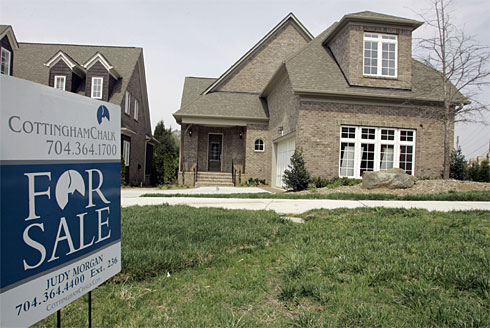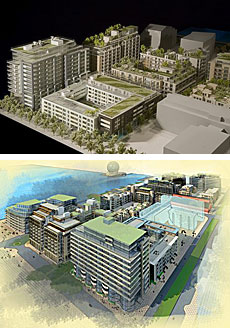Christine Dugas
USA Today

The housing market remains volatile as new-home sales slide and more than 2.1 million Americans with home loans missed at least one payment last year, according to the Mortgage Bankers Association. By Chuck Burton, AP
You’re a would-be buyer who’s been sitting stubbornly on the sidelines, having seen home prices soar to nonsensical levels, waiting for their inevitable fall back to Earth. Eventually, you say, the time will be right to tiptoe into the market.
Lately, you’ve seen prices slipping. And you’ve heard about foreclosed homes being thrown on the market at bargain prices.
Well? Are we there yet? Should you check out a discounted home in foreclosure? After all, there will be more than 1 million foreclosures over the next two years, according to the National Association of Realtors. A house in foreclosure might well offer a great deal.
Michelle Mangione knows. She and her husband, Jeff Haag, are living in a home in Fallbrook, Calif., that she bought from the owner about three years ago, just before it went into foreclosure. Having paid about $680,000, she estimates she saved about $200,000.
Still, her savings came at a price: a lot of needed work on the house. “You have to be willing to live in a mess for a while,” Mangione said recently, as painters were working in the home.
Buying a home in foreclosure isn’t easy, and it’s hardly without risk. Before you consider plunging into the foreclosure market, be sure to do some in-depth research.
“There are some good buying opportunities,” says David Lereah, the NAR’s chief economist. “But don’t repeat the mistakes of the foreclosed borrowers.”
Until recently, some buyers saw little risk in rushing into an adjustable-rate mortgage or an exotic loan with a low or no down payment. Now, many are stuck with soaring payments they can’t afford.
With the market sinking for “subprime” borrowers — those with shaky credit or little money to put down — buyers short on cash are finding it harder to get a mortgage. Before you try to buy a home in foreclosure, be sure you have a good credit score and enough cash for a sizable down payment. Prime borrowers, Lereah notes, should still be able to qualify for traditional fixed-rate loans with rates remaining near historic lows.
If you do shop for a home in foreclosure, don’t reel in the first one you see. In particular, don’t get sucked into an auction right away. Auctions aren’t the only way to buy a home in foreclosure, and they can sometimes be the most hazardous.
Here are your main options:
Auction.
The typical one is a state process. It’s generally held on the courthouse steps, in the clerk’s office or in front of the foreclosed house.
“The auction probably represents the highest potential return but also the highest risk,” says Rick Sharga of RealtyTrac, which tracks foreclosures.
That’s because buyers typically can’t inspect the home in advance of the auction and must pay on the spot in cash or with a cashier’s check. It’s also possible that the current homeowners will refuse to move out, and then you must deal with an eviction, says Alexis McGee of Foreclosures.com, which provides advice on buying foreclosed homes.
REO (real estate owned)
If a foreclosed home isn’t sold at auction — if, for example, the highest offer is less than the homeowner owes the lender — the bank would repossess it. Though the bank will want to unload the home, it won’t necessarily do so cheaply. So you aren’t guaranteed a fabulous price.
“The bank can take their time in responding to an offer,” says Jim McEachern, a buyer’s agent in Las Vegas. “It’s just a piece of paper on a banker’s desk.”
Still, you’ll be able to arrange an inspection and title insurance. In that way, it’s safer than an auction.
Jenny Nelson recently bought a home in Stone Mountain, Ga., from the lender that seized it. She had time to research the home, which had been empty for about a year and was in rough shape. “It’s nerve-racking to think what could have happened to this house,” she says. Nelson had heard that when the house was vacant, homeless people had moved into it for a while.
Once Nelson hired an inspector, she learned that a broken pipe in the basement had caused mold to grow. Nelson, who had the problem repaired and cleaned up, plans to move in in June.
Pre-foreclosure.
Because an auction is risky and an REO is more costly and time-consuming, some experts recommend buying a home in pre-foreclosure.
You can find a house in pre-foreclosure by studying the public notices about homes in default. The information is available from such Internet firms as Homeforeclosures.com, HomeForeclosure.com and RealtyTrac. You’ll pay a fee, though, for their services.
Plus, there will be little if any competition because the home usually isn’t up for sale. It’s a private deal. You offer a price that’s less than market value but more than the amount owed on the bank loan.
“The thing that makes it difficult for people,” McGee notes, “is the idea of soliciting somebody who hasn’t put a for-sale sign up front.”
Buyers don’t all have the same opportunities, because the number of foreclosures varies considerably across the USA. The top states now include Ohio, Indiana and Michigan, according to the Mortgage Bankers Association.
Now may be a good time, for example, to buy a home in the Detroit area. “Homes are a lot more affordable than they’ve been for the last 15 years, and our inventory is at least double what it normally is,” says Ron Simpson of the Detroit Association of Realtors.
Simpson says he recently sold one home in foreclosure for $415,000 that would have cost $600,000 not long ago.
Not every would-be buyer in such areas, of course, can capitalize on the attractive prices, because many have lost jobs themselves. In fact, the main reason for foreclosure is unemployment, says Jay Brinkmann of MBA.
But be aware: Some homeowners don’t even try to stop foreclosure, because of something wrong with the neighborhood or structurally with the house.
“There are various reasons for people to live rent-free for close to a year, ride through the process and let it go into foreclosure,” Brinkmann says.
If you’re too nervous about buying a home in foreclosure, consider other options to find attractive deals. The overbuilding of homes in some parts of the USA, for example, has swelled the supply for buyers.
Some who have done it say buying a home in foreclosure is best suited to buyers who can accept the stress and hard work.
“You have to have vision and patience and be able to live in a little chaos,” says Mangione, the happy buyer.






